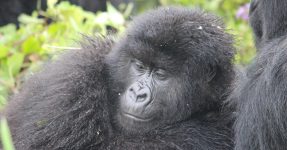About Mountain Gorillas in Africa
Mountain Gorillas in Africa – Uganda: There is a bigger number of mountain gorillas in Uganda compared to other countries. With only about 1030 mountain gorillas left on Earth, these giant apes are endangered under the IUCN Red list and live within the forests of Bwindi as well as the Virunga Mountains of East-Central Africa. These beautiful creatures are sub-species of Eastern gorillas (scientifically referred to as Gorilla Beringei), where they belong together with the Eastern lowland gorillas of the Democratic Republic of Congo.
Like their name, the mountain gorillas occupy the high mountains of East-Central Africa at altitudes of 2500 to 4000 meters above sea level. In terms of natural habitats, they prefer the lush volcanic slopes of the Democratic Republic of Congo, Uganda, and Rwanda, especially in areas that have unfortunately suffered human violence making these Great Apes escape and fear for their lives. The scientific name of these primates is Gorilla beringei beringei.
From the time mountain gorillas were discovered in 1902, their wild population has suffered decades of civil wars, poaching and hunting, illegal bush meat sale, fragmentation, and loss of their natural habitats as well as diseases that have unfortunately threatened their existence, to the point of making them endangered.
Talking of their lineage, mountain gorillas are descendants of ancestral monkeys and Great Apes found in the African Continent as well as Arabia during the beginning of the Oligocene epoch (between 34 and 24 million years ago). Physically, these giant apes have darker, longer, and thicker fur, enabling them to comfortably survive in their natural environment marked by cold temperatures.
Male Mountain gorillas measure 63 to 67 inches in terms of standing height, with arm length of 2 to 2.7 meters. Their weight ranges between 120 and 190 kilograms while the females are slightly smaller with body weight of 80 to 100 kilograms. Compared to the other subspecies of Eastern gorillas, the mountain gorillas are smaller in size.
Matured male mountain gorillas are marked by more protruding bony crests at the top as well as back of their skulls thus creating a conical shape of their heads. The strong temporalis muscles are found on their crests and these are attached to the lower jaw. While females also possess the crests, they are less protruding. “Silverback” is the name given to matured mountain gorillas, owing to the saddle of silver or gray-colored hair that appears on their backs and hips as they grow older. Not only that, the fur on the backs is shorter or non-existent compared to other parts of their bodies.
Mountain gorillas in Africa are primarily terrestrial (meaning they spend the largest time of their lives on the ground) and quadrupedal (move on all their four limbs), although incidences of tree climbing, especially when picking fruits existent in Mountain gorillas.
Their feeding Habits
Being primarily herbivores, the mountain gorillas mainly feed on stems, leaves, and bamboo shoots that make up 86% of their diet. Tree barks make up 7% of mountain gorilla diet, roots 3%, flowers make up 2% of their diet, and fruits are 2% of their diet. These Great Apes also feed on snails, ants, and termites which comprise about 0.1% of their diet. One of the most interesting things about them is that they spend the largest time of the day foraging on huge chunks of food required to sustain their large bulk. An adult male can consume up to 20 kilograms of vegetation each day while the females need about 15 kilograms of food each day to survive.
Being social beings, mountain gorillas live in relatively stable and harmonious groups that are held together by long-term partnerships between adult females and males. However, these friendships among females are slightly weak. These mountain gorilla troops/families are usually non-territorial with the responsibility of defending the troop (not territory) entirely lying on the shoulders of silverbacks. He also makes decisions on the movement, feeding patterns, solving conflicts, nesting, and others. When it comes to threats to his troop, the silverback will fight with all his might against other gorillas, humans, leopards, and others to the point of losing his life in the process.
Gestation Period in gorillas
Female mountain gorillas give birth to a single baby after 8.5 months of pregnancy. Although an adult gorilla is strong and heavily built, the young ones are born tiny and vulnerable, usually weighing between 1.8 and 2 kilograms. Given the vulnerability, these babies are carried on their mothers’ backs between four months and three years.
The natural habitats of mountain gorillas are mainly Albertine Rift montane cloud forests (such as the Virunga volcanoes)-extending between 2500 and 4000 meters above sea level. Some live in the bamboo forest, sub-alpine regions, and dense tropical rainforests (especially within Bwindi Impenetrable National Park).



















